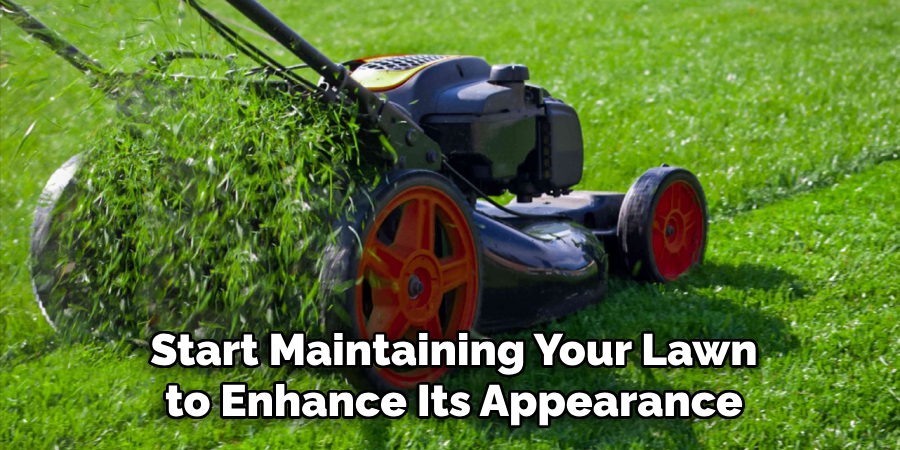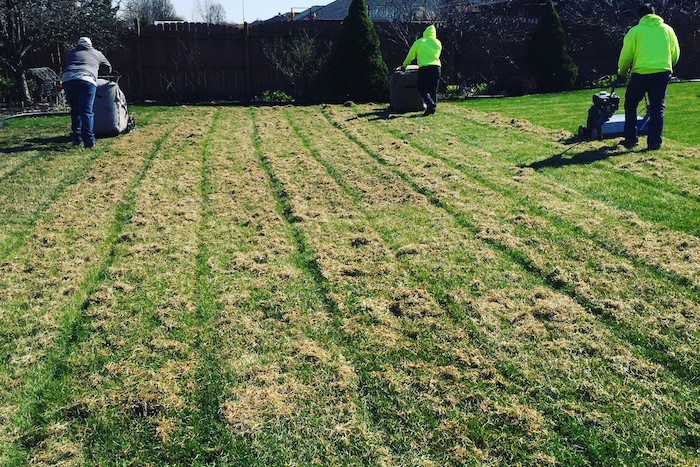To verticut your lawn, you need to carefully follow these steps: prepare the lawn by mowing it at a lower setting, rent or purchase a vertical cutting machine, adjust the depth of the blades, and make multiple passes over the grass in different directions. Verticutting helps remove thatch and promote healthier grass growth.
By using these simple techniques, you can ensure a well-maintained and beautiful lawn.

Credit: www.greenscapedesigninc.com
Why Verticutting Is Essential For A Healthy Lawn?
Verticutting is a crucial practice for maintaining a healthy lawn as it offers several benefits. This process involves removing the thatch layer, which enhances nutrient and water penetration, ensuring their optimal absorption by the roots. By doing so, verticutting promotes healthy growth, reduces weed proliferation, and increases the lawn’s overall resilience.
Another advantage of verticutting is that it stimulates lateral growth, resulting in a denser turf. Additionally, this practice helps to prevent the accumulation of excessive thatch, which can lead to various lawn issues. For optimal results, it is recommended to verticut your lawn during its active growth period to allow it to recover quickly.
Understanding the process and following these guidelines will ensure that you effectively verticut your lawn, keeping it healthy and beautiful throughout the year.
Choosing The Right Time For Verticutting
Choosing the ideal time for verticutting depends on the condition of your lawn and several factors. Firstly, assess the current state of your lawn before deciding when to verticut. Take note of any weeds, bare spots, or compacted soil. Secondly, consider the best seasons for verticutting.
Generally, spring and fall are optimal as they provide the necessary conditions for grass regrowth. However, avoid verticutting during the hottest and coldest months of the year. Additionally, factors such as soil moisture and temperature can impact the success of verticutting.
Aim to verticut when the soil is damp but not overly saturated. Furthermore, scheduling the procedure before applying fertilizer can enhance lawn health. By carefully considering these aspects, you can choose the right time to verticut your lawn and ensure the best results.
Step-By-Step Guide On How To Verticut Your Lawn
Verticutting your lawn can be a beneficial practice with proper preparation. Before starting, adjust the verticutter settings to the desired depth. Ensure you are verticutting in the right direction, preferably perpendicular to the previous mowing. Take note of any problem areas, such as compacted soil or thatch build-up, and address them accordingly.
After verticutting, it is essential to provide post-verticutting care and maintenance. Regular watering and fertilization will help the grass recover and grow stronger. Avoid heavy foot traffic on the lawn for a few weeks to allow it to heal properly.
By following these steps, you can achieve a healthy and well-maintained lawn through verticutting.
Tools And Equipment Required For Verticutting
Verticutting your lawn requires specific tools and equipment. To begin, it’s essential to understand the different types of verticutters available. Additionally, having the necessary safety equipment is crucial to ensure a safe and successful process. Once you have the right tools and safety gear, it’s important to maintain them properly.
Regular cleaning, sharpening, and lubrication will keep your verticutting tools in top condition. By following these guidelines, you can achieve a well-maintained and healthy lawn with the help of verticutting. So, gather your tools, equip yourself with the required safety gear, and start maintaining your lawn to enhance its appearance and overall health.

Common Mistakes To Avoid When Verticutting Your Lawn
Common mistakes to avoid when verticutting your lawn include overdoing the process and ignoring proper blade height adjustment. Overdoing the process can lead to excessive damage and stress on your lawn. It’s important to follow recommended guidelines for verticutting to maintain a healthy lawn.
Another mistake to avoid is improper blade height adjustment. Setting the blades too low can scalp the grass and create bare patches, while setting them too high may not effectively remove thatch and improve airflow. Finding the appropriate blade height for your specific type of grass is crucial.
Additionally, after verticutting, many people overlook the importance of irrigation. Proper watering is essential to promote the recovery and growth of the grass. By avoiding these common mistakes, you can successfully verticut your lawn and achieve a lush, healthy, and beautiful outdoor space.
Tips For Enhancing Verticutting Results
Verticutting your lawn can greatly enhance its health and appearance. Regular mowing and fertilization are important factors in achieving optimal verticutting results. Ensuring your lawn receives proper watering techniques is also crucial. Overwatering can lead to shallow root growth, while underwatering can cause stress and brown patches.
Dealing with thatch buildup is another aspect to consider. Thatch, a layer of dead grass and debris, should be removed to allow the roots to breathe and access nutrients. Using a verticutter machine or dethatcher can effectively remove thatch. By following these tips and maintaining a consistent verticutting routine, you can achieve a lush and vibrant lawn.
So, be sure to give your lawn the attention it deserves and enjoy the results of a well-maintained, verticut lawn.
Troubleshooting Verticutting Problems
Patchy areas after verticutting can be a common problem in lawns. While verticutting helps remove thatch and promote healthy growth, it can sometimes result in uneven areas. To address this, it’s important to ensure that you are using the correct blade depth when verticutting and not going too deep into the soil.
Additionally, make sure to regularly water your lawn before and after verticutting to promote even growth and recovery. Weed infestation after verticutting can also occur, especially if the soil is disturbed during the process. To prevent this, consider applying a pre-emergent herbicide before verticutting to inhibit weed growth.
Soil compaction issues can also arise, hindering grass growth. To avoid this problem, periodically aerate your lawn to alleviate soil compaction and promote better nutrient and water absorption. By troubleshooting these common verticutting problems, you can maintain a healthy and vibrant lawn.

Frequently Asked Questions On How To Verticut Your Lawn
What Is Verticutting And Why Is It Important For Your Lawn?
Verticutting is a lawn care technique that involves cutting vertical lines into the grass to remove thatch and improve airflow, water penetration, and nutrient absorption. It helps promote healthier turf growth and prevents issues like fungus and pests.
How Often Should I Verticut My Lawn?
The frequency of verticutting depends on various factors, such as turf type and condition, but in general, it is recommended to verticut your lawn once or twice a year. Spring and fall are usually the best times to do it, as the weather conditions are favorable for grass recovery.
Can I Verticut My Lawn On My Own, Or Should I Hire A Professional?
Verticutting can be done by both homeowners and professionals. If you have a small lawn and feel confident in your abilities, you can do it yourself with the right equipment and proper technique. However, for larger or more complicated lawns, it may be beneficial to hire a professional to ensure the job is done correctly.
What Equipment Do I Need For Verticutting My Lawn?
To verticut your lawn effectively, you will need a verticutter or dethatcher machine, which are specifically designed for this purpose. Additionally, you may need a lawn mower, rake, and grass seed to complete the process. It is essential to use the right tools and equipment to achieve optimal results.
Are There Any Precautions I Should Take Before And After Verticutting My Lawn?
Before verticutting your lawn, it is essential to mow it shorter than usual and remove any debris. After verticutting, you should water your lawn thoroughly and consider applying fertilizer or overseeding if necessary. Avoid heavy foot traffic on newly verticut grass to allow it to recover and grow properly.
Will Verticutting Damage My Lawn?
When done correctly, verticutting should not cause significant damage to your lawn. However, improper technique or excessive aggressiveness can harm the grass. It is crucial to follow the recommended guidelines, adjust the machine settings properly, and avoid verticutting too frequently or during stressful periods for the grass.
Conclusion
Implementing verticutting techniques can greatly improve the health and appearance of your lawn. By removing thatch and promoting better air circulation, your grass will have a stronger root system and be more resistant to diseases and pests. Regularly verticutting also encourages new growth, resulting in a thicker, lusher lawn.
Remember to follow the proper timing guidelines for your grass type and utilize the correct equipment to achieve optimal results. With a careful approach and consistent maintenance, your lawn will transform into the envy of the neighborhood. So, don’t hesitate to try verticutting as part of your lawn care routine and enjoy the benefits of a healthy and beautiful lawn for years to come.
Happy verticutting!

